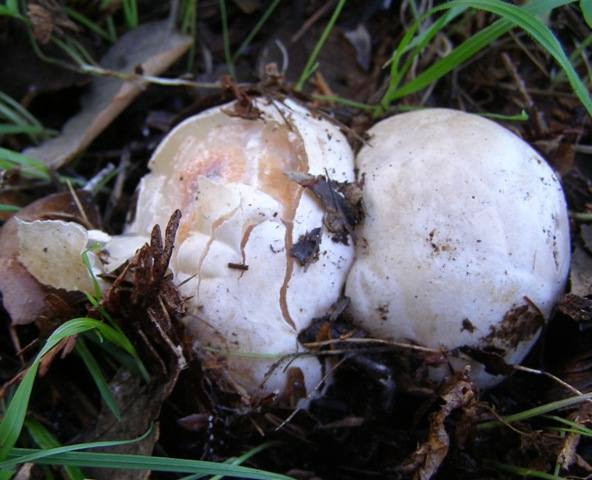At One with Nature - Raising a Stink
Sue Parker finds a family of fungi not to be sniffed at
Based on an article by Sue Parker in Algarve Resident, November 2016. Algarve Resident is the leading English-language newspaper and the source of essential information for Residents and would-be Residents in the Algarve.
For more information about Algarve Resident...
What’s the difference between a male goat and an impudent mushroom? Even with your eyes closed you know soon enough if a billy goat is racing towards you: you smell the pong before the hard horns hit home. With Stinkhorns a strong pong hits you first but the harmless horns are soft and squishy.
Phallus impudicus is perhaps the most common and widespread of a group of fascinating fungi known collectively as the family Phallaceae. Of the many hundreds of stinkhorn species the majority occur in the tropics; however, here in the Algarve we have quite a selection too, remarkable both for the variety of their colours and for the diversity of their forms.

Cage Fungus Clathrus ruber is a common sight in Algarve woodlands and on grassy roadside verges
Gwen Raverat, granddaughter of Charles Darwin, described how her Aunt Etty was so shocked by the form of Common Stinkhorns that she would scour the woods daily to collect any that were freshly emerged, bringing them back to burn on the drawing-room fire behind locked doors ‘...because of the morals of the maids.’ No wonder these phallic fungi came to be ascribed with aphrodisiac properties!
Disgust was not restricted to the Common Stinkhorn. The Starfish Fungus (also known as Sea Anemone Fungus) was given the scientific name Aseroë rubra, which translates to ‘disgusting red’. Some say that this species was imported to Europe from Australia; others conclude that it is also native to South Africa, where it is certainly very common, and has spread northwards from there. Whatever the case, the Starfish Fungus remains quite a rare find on the Iberian Peninsula. Reputation and reality don’t always coincide, of course, but the eggs from which stinkhorns emerge are reputed to be edible and possibly even delicious. One report says ‘best when pickled’, but it is unclear whether the adjective applies to the morsel or to the mortal. (I have yet to meet anyone who can vouch for these delicacies from personal experience, so perhaps it is a Phallacy!). Often found feeding on leaf litter, decaying twigs, woodchip and sawdust where roadside trees have been cut back and shredded, the Red Cage fungus Clathrus ruber also erupts from a near-spherical egg with a white rubbery eggshell or volva. As the cage expands, the volva remains at the base like a misshapen eggcup.

Five other stinkhorns worth looking (or sniffing) out for – L to R: Common Stinkhorn Phallus impudicus, Dog Stinkhorn Mutinus caninus, Devil’s Fingers Clathrus archeri, Starfish Fungus Aseroë rubra, and the uncommon but very distinctive Colus hirudinosus.
All of the stinkhorn fungi have volvas. It is the colour of the volva that separates Phallus impudicus from the otherwise similar Phallus hadriani, the Dune Stinkhorn. Look (or sniff) out for this pink-egged stinkhorn among Marram grass in coastal sand dunes. It is said that the devil has his fingers in many pies, not all of which are good to eat; however, in the fungal kingdom you could catch him red handed by following your nose in grassy riverside meadows. There you might come across Devil’s Fingers Clathrus archeri, a stinkhorn of distinction from whose eggs spring five or more bright red fingers each coated on one side with green spore-laden gluten. It is the smelly gluten of stinkhorns that attracts flies from far and wide to feast of the foetid fingers, phalanxes, lattice-like cages and other strange structures that these fungi produce to proliferate their kind. As the flies feed so their feet get coated in spores, some of which are deposited wherever the insects next wipe their dirty boots – and if that’s where new stinkhorn colonies form then future generations of flies will prosper too.

The eggs from which stinkhorns emerge are reputed to be edible. Red Cage fungi are ready to burst through the skins of this pair of delicacies.
There are plenty of red or orange stinkhorns, but others are green, yellow, brown, or white. Colour is no more a shared feature than size or shape, but the one thing all stinkhorns have in common is a pong strong enough to attract flies that will put their feet in it and thereby ensure the spreading of fungal spores. When a species is considered inferior, the prefix ‘dog’ is often part of its common name. Dog Violets may look very much like Sweet Violets, but they lack the wonderful scent of their illustrious superiors. Dog Stinkhorn Mutinus caninus is inferior to the Common Stinkhorn in two ways: it is much smaller and much less smelly; however, this woodland fungus is equally short lived and far less common – or at least much harder to find and hence far less frequently recorded. There are almost certainly several other stinkhorns in the Algarve whose small size and shady habitats ensure that they remain unseen by most of us. For example I have yet to come across Colus hirudinosus, a close relative of the Red Cage fungus but with an elongated and more perfectly formed lattice. This neat little stinker is found in southern Europe, South Africa, parts of Asia, and Australia, but if flies have spread its spores to all these places then they are certainly intrepid intercontinental travellers! Or is this, again, the work of the Devil?

